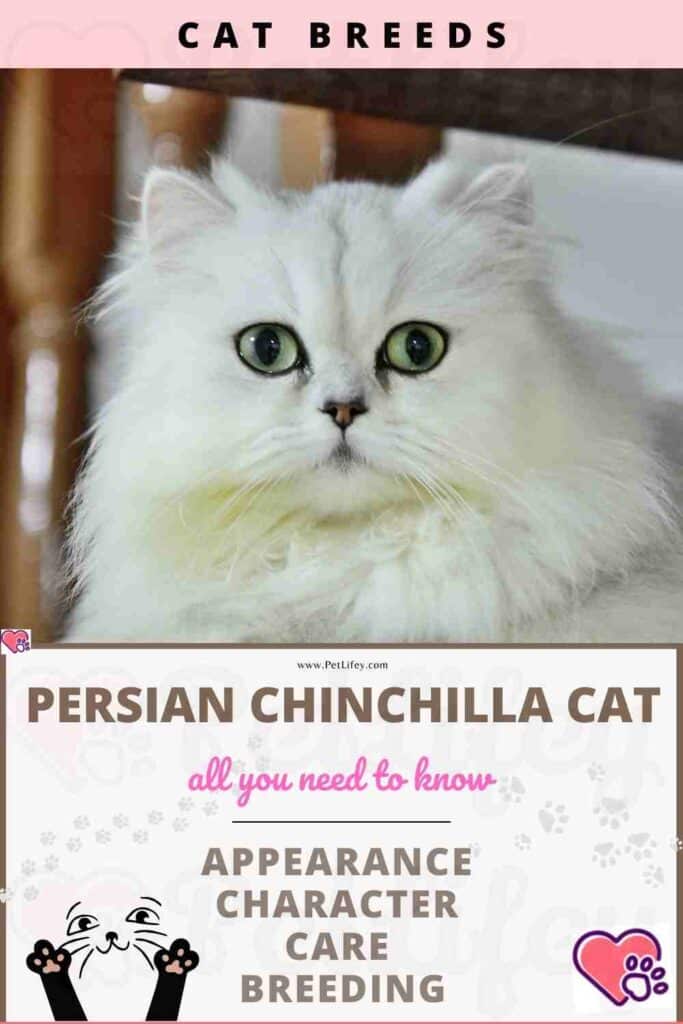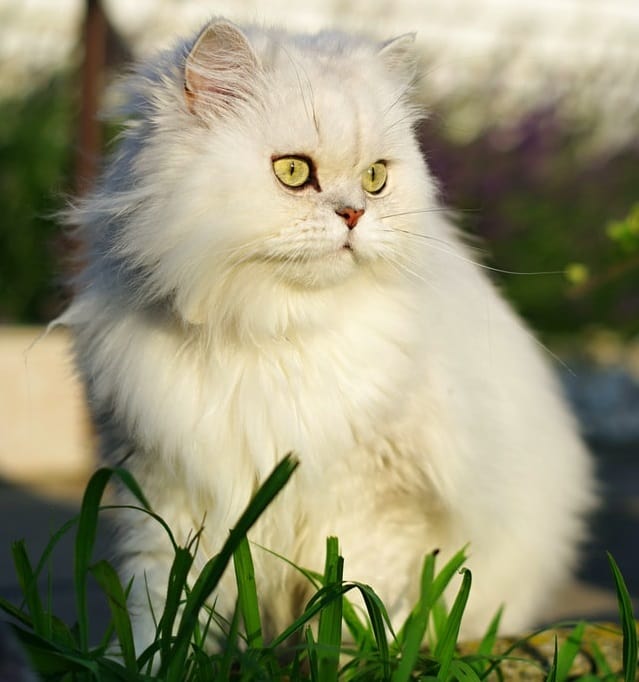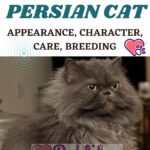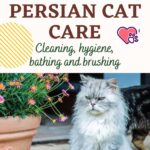
The Persian Chinchilla cat is a special variety of Persian. At the end of the 19th century, it achieved great success and became a celebrity, to the point that their body was embalmed after its death and that it rests in the current Museum of Natural History in South Kensington, London.
The origins of the Persian Chinchilla Cat

The history of this cat begins in 1880 in England: Mrs. Vallance had the idea to mate a Persian smoke with a silver tabby, from which a female was born who gave birth, after another mating, to the first specimen of the cat Chinchilla, called silver Lambkin.
Then, thanks to Princess Victoria, the Queen’s niece, the Chinchilla spread throughout the UK.
Chinchilla cats belong to the silver tabby category but, subjected to a serious and precise selection program, the tabby factor has become almost imperceptible, leaving only the tip of the colored coat (tipping).
The tipping on the coat of cats having different lengths, the FIFE (International Feline Federation) separated in the sixties the “silver” into two classes: the Chinchilla and the silver shaded.
Appearance of the Persian Chinchilla Cat
The Chinchilla cat’s coat has a very light colored base, and the tip of each hair is colored one-eighth of its length. The muzzle, neck, belly, inside of the legs and the lower part are characterized by their white color.
The fingertips are in harmony with the color of the tipping (today the colors black, blue, chocolate and lilac are allowed). The nose is brick pink bordered with black (or blue, or chocolate, or lilac).
The eyes are the characteristic of this breed, making this variety unique: their color is emerald green and the contour of the eyelids, which appears to be made up, is reminiscent of the color of the coat.
The length of the tipping, which then represents a third of the length of the hair, distinguishes the silver shaded from the Chinchilla. The tipping is much more visible and more intense in tone on the legs and under the eyes.
As with the Chinchilla, the collar, the belly, the inner part of the legs and the lower part of the tail are white.
To these two varieties, it is also advisable to add the Golden which has golden traces in the undercoat. It has only been recognized for a few years, although its appearance is not recent.
It seems in fact that, during the Chinchilla breeding program, it happened that subjects with golden undercoat were born; their birth (1925) was probably due to a recessive gene which disappeared for many years and then resurfaced.
The Golden is in every way similar to the Chinchilla and the only difference is therefore this slight gilding of the undercoat as well as the black and tawny tip. The Golden are also divided into two classes on the basis of their coloring.
We find the Golden shell, whose golden tone is distributed over the tip of the hair for one eighth of its length and the Golden shade, whose tipping occupies only one third of the length of the hair.
The character of the Persian Chinchilla Cat
The character of the Chinchilla cat is in every way similar to that of a Persian. Only the Golden stands out: it seems to have a bit more of a naughty character.
Hug:
The Silver Persian is affectionate towards their human but he also likes his tranquillity. Long sessions of cuddling are not necessarily for him, but each cat has its own personality.
Player:
The Persian Chinchilla can be mischievous, but it is quite lazy by nature.
Calm:
Like the Persian, it is of a calm nature and likes his environment to resemble them.
Intelligent:
It is an observer and knows how to make themselves understood at a glance.
Fearful / Suspicious of Strangers:
More reserved than fearful, the Persian Chinchilla needs time to adjust to new people.
Independent:
Very attached to their comfort and tranquillity, it will prefer to stay away if the hustle and bustle of family life bothers them.
Behavior of the Persian Chinchilla Cat
Talkative:
Rather discreet, it prefers to be understood by the look than by the meowing.
Greedy / gluttonous:
Rather lover of good things, the food should be offered in an interactive bowl to regulate food intake and avoid being overweight.
Need for exercise:
Like all cats, the Persian Chinchilla needs to exercise. However, its morphology limits the intensity and duration of play sessions.
Runaway:
It is a cat who likes the comforts of home, even if it is not against a little outing from time to time.
Compatibility of the Persian Chinchilla Cat with other animals
The Persian Chinchilla and the Dogs:
If the introduction is done well, it is possible that the Silver Persian tolerates the presence of dogs very well. However, it preferred calm individuals to rowdy, energetic canines. It is essential to provide heights and hiding places so that it feels comfortable there.
The Persian Chinchilla and Other Cats:
As with dogs, it will adapt to companions as peaceful as itself. It will need time to adapt to community life.
The Persian Chinchilla and Children:
Particularly gentle and tolerant, it will be a good companion for children as long as they know how to respect the cat’s needs and are not rowdy.
The Persian Chinchilla and the Elderly:
This is surely the best breed of cat for a rather calm person because it likes their environment to be quiet and devoid of events breaking their routine, provided that this person knows how to groom them on a daily basis. .
Price of the Persian Chinchilla Cat
On average, the purchase price of a Persian Chinchilla kitten in breeding is between 600 USD and 2800 USD, the price often varying according to the line, the breeding, the age or even the sex.
For the monthly budget, it will take an average of 50 USD / month to meet the needs of this cat, by offering him a quality diet and making sure to keep them in good health.
Maintenance of the Persian Chinchilla Cat
Grooming:
Grooming the Persian Chinchilla is particularly demanding: brushing should be daily to avoid knots and remove dead hair. This can be more easily removed with a bath, followed by good drying. The long hairs on the hindquarters can sometimes be soiled by the stool and therefore should be checked regularly. Cutting and mowing will sometimes be necessary to facilitate maintenance.
Cleaning the eyes and wings of the nose must also be daily due to its flat face. Indeed, the secretions can color his very light hair but also cause infections. Also remember to check the cleanliness of the ears frequently.
Hair loss:
The Silver Persian will certainly leave traces of its naps on fabrics and sofas.
Food for the Persian Chinchilla Cat
The shape of its face and therefore of its jaw but also its type of hair are the two main elements to take into account when choosing food. Obviously, it will need to be of high quality and provide it with the nutrients it needs for good health.
Health of the Persian Chinchilla Cat
Life expectancy:
It is quite variable due to the relative fragility of this breed, which can range from 12 to 18 years.
Resistant / Robust:
Its physical characteristics make it a perfect indoor cat. Indeed, its morphology does not allow it to breathe properly both during high heat and in the middle of winter. Its abundant undercoat keeps it warm but tangles easily.
Tendency to gain weight:
This placid and greedy feline is prone to overweight. The choice of food and the intake thereof should be carefully controlled.
Common diseases:
The Persian Chinchilla is predisposed to develop certain hereditary diseases:
Nephrology-urology:
- Polycystic kidney disease: cysts gradually and slowly appear on the kidneys, hindering their proper functioning. There is a screening test for this disease
- Idopathic cystitis: This inflammation of the bladder is often seen in castrated males. There are many causes but often unidentified
- Urolithiasis (or urinary stones): usually appear after 7 years, mostly in sterilized animals and males
Cancerology:
- Basal cell tumor: mostly benign, these skin tumors are often located in the head and neck
- Tumor of the sebaceous glands: these benign skin tumors can be single or multiple
Cardiology:
- Hypertrophic heart disease: heart disease characterized by thickening of the myocardium
- Pericardo-diaphragmatic hernia: an abnormality in the development of the diaphragm leading to the passage of the abdominal organs into the pericardial cavity
Ophthalmology:
- The progressive retinal atrophy , which causes loss of vision almost from birth
- Corneal sequestration (or corneal necrosis)
- Coloboma of the eyelids: malformation of the outer part of the upper eyelids
- Entropion: malformation causing the edge of the eyelid to roll inwards
- Idopathic epiphora: tear secretion abnormality linked to the shape of the Persian’s head
Dermatologies:
Ringworm: a yeast infection most often developing on the back or at the base of the tail causing ulcerated nodules
Cryptorchidism, testicular monorchidism: absence of descent of the testes or of a single
It can also one day develop the same pathologies as any other cat, such as oral pathologies .
From the age of 7, it is advisable to carefully monitor your health by having an annual health check-up at the veterinarian.
Reproduction:
Females give birth to fewer litters than other breeds. In addition, farrowing must be supervised. Indeed, kittens with a large skull may have difficulty being expelled. Cesarean sections are quite common.
The reproduction of the Persian Chinchilla is particular because, the green color of the eyes being recessive, it can disappear if the crossing is made with a variety with blue or copper eyes for example. The coat color can also become too light if the crosses are done only with the Persian Chinchilla.
Good to know
There are other types of Persian Chinchillas such as the “Silver shaded”, recognized in the 1970s, of which the “tipping”, which represents a third of the hair, is more visible on the coat and more marked on the legs and under. the eyes.
There is also the “Golden”, which has golden undertones in the undercoat and black tail tip. This can be “shadded”, ie one third of the hair is colored, or “shell”, with one eighth of the hair colored. These have only been recognized for a few years, when we note the appearance of this gene in 1925.
Finally, the Persian Cameo, which is a breed in its own right in the United States, but a variety of Chinchilla in France and England. This one wears a dress called “red silver shaded”: the base of the hair is silver or ivory and the point is red.






